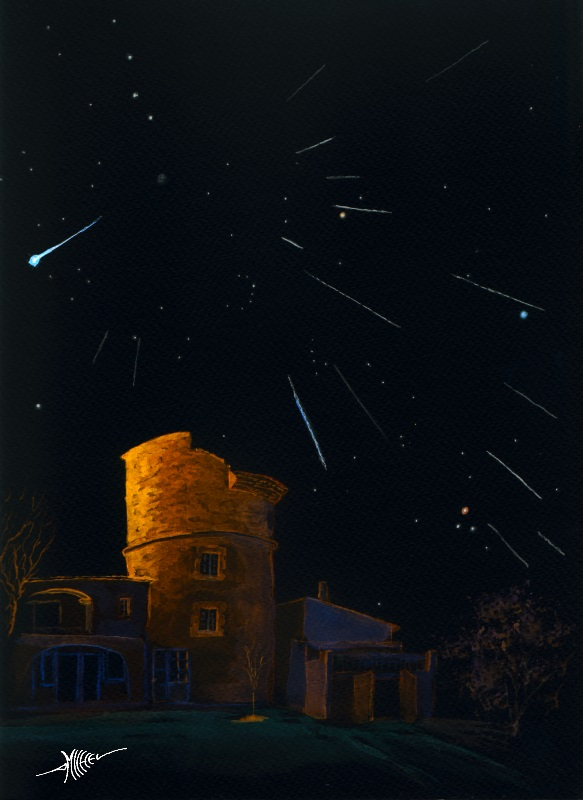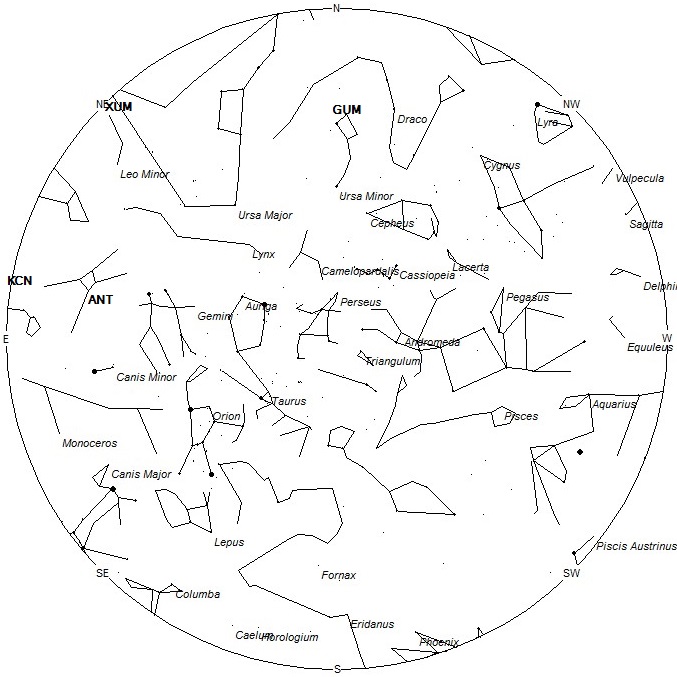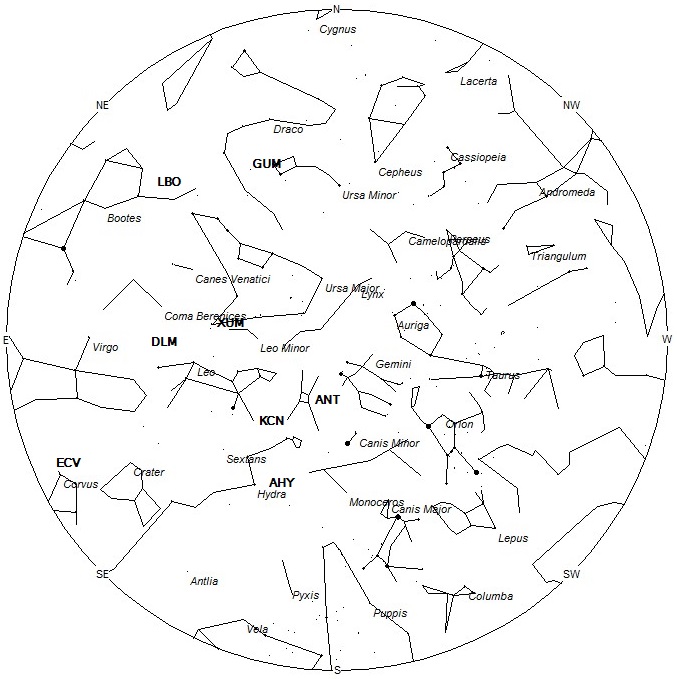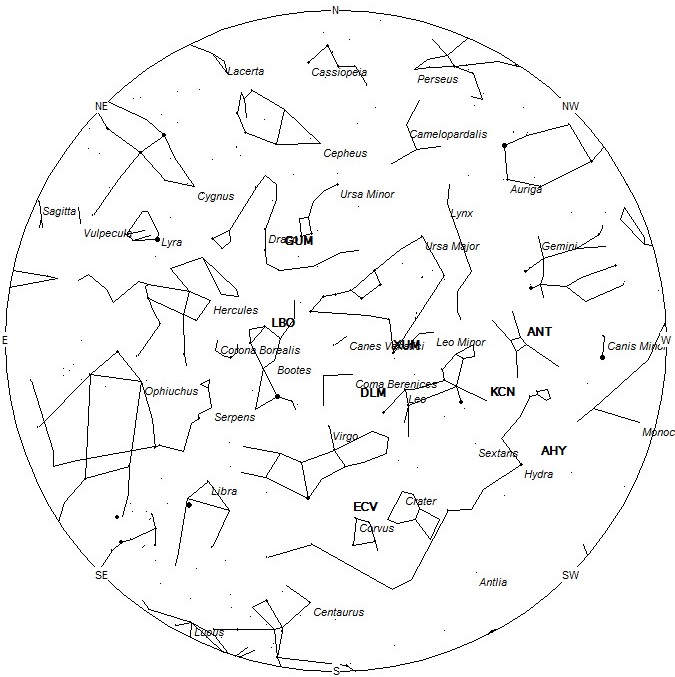
During this period the moon reaches its last quarter phase on Friday January 17th. At that time the moon will lie 90 degrees west of the sun and will rise near midnight local standard time (LST). This weekend the nearly full moon will rise as dusk ends and will remain in the sky all night long. It will rise later with each passing night but will still greatly interfere with meteor observations during the more active morning hours. The estimated total hourly meteor rates for evening observers this week is near 3 for those viewing from the northern hemisphere and 3 for those located south of the equator. For morning observers the estimated total hourly rates should be near 6 as seen from mid-northern latitudes (45N) and 5 as seen from tropical southern locations (25S). The actual rates will also depend on factors such as personal light and motion perception, local weather conditions, alertness and experience in watching meteor activity. Rates are reduced due to moonlight. Note that the hourly rates listed below are estimates as viewed from dark sky sites away from urban light sources. Observers viewing from urban areas will see less activity as only the brightest meteors will be visible from such locations.
The radiant (the area of the sky where meteors appear to shoot from) positions and rates listed below are exact for Saturday night/Sunday morning January 11/12. These positions do not change greatly day to day so the listed coordinates may be used during this entire period. Most star atlases (available at science stores and planetariums) will provide maps with grid lines of the celestial coordinates so that you may find out exactly where these positions are located in the sky. A planisphere or computer planetarium program is also useful in showing the sky at any time of night on any date of the year. Activity from each radiant is best seen when it is positioned highest in the sky, either due north or south along the meridian, depending on your latitude. It must be remembered that meteor activity is rarely seen at the radiant position. Rather they shoot outwards from the radiant so it is best to center your field of view so that the radiant lies at the edge and not the center. Viewing there will allow you to easily trace the path of each meteor back to the radiant (if it is a shower member) or in another direction if it is a sporadic. Meteor activity is not seen from radiants that are located below the horizon. The positions below are listed in a west to east manner in order of right ascension (celestial longitude). The positions listed first are located further west therefore are accessible earlier in the night while those listed further down the list rise later in the night.
These sources of meteoric activity are expected to be active this week.
The detailed descriptions of each source will continue next week when viewing conditions will become much improved.
| SHOWER | DATE OF MAXIMUM ACTIVITY | CELESTIAL POSITION | ENTRY VELOCITY | CULMINATION | HOURLY RATE | CLASS |
| RA (RA in Deg.) DEC | Km/Sec | Local Standard Time | North-South | |||
| Anthelion (ANT) | – | 08:16 (124) +19 | 30 | 01:00 | 2 – 1 | II |
| alpha Hydrids (AHY) | Jan 03 | 08:52 (134) -11 | 43 | 02:00 | <1 – <1 | IV |
| kappa Cancrids (KCN) | Jan 10 | 09:24 (141) +08 | 50 | 02:00 | <1 – <1 | IV |
| December Leonis Minorids (DLM) | Dec 21 | 12:00 (180) +21 | 63 | 05:00 | <1 – <1 | II |
| eta Corvids (ECV) | Jan 16 | 12:11 (183) -13 | 68 | 05:00 | <1 – <1 | IV |
| lambda Bootids (LBO) | Jan 16 | 14:29 (217) +45 | 41 | 07:00 | <1 – <1 | IV |
| gamma Ursae Minorids (GUM) | Jan 18 | 15:10 (228) +71 | 30 | 08:00 | <1 – <1 | IV |
| xi Coronae Borealids (XCB) | Jan 16 | 16:36 (249) +30 | 49 | 09:00 | <1 – <1 | IV |
 American Meteor Society
American Meteor Society



Just saw a small meteorite in Clermont Fl 34714 Rt 27 by the Thousand Trails entry, traveling south to north. 11:58 PM 1/16/20. Green/Blue color.
I saw it too from Orlando Airport. Traveling south to north, long and brilliant. It seemed to have a piece break off about mid event.
If anyone can comment about known meteor shower activity in the area it would be appreciated. I am not sure If this was celestial or space junk reentering.
DJ and All,
This event was most likely a true meteor as I did not see an predicted re-entries for that time and location. You can see the event page, which has more information for this object at: https://fireball.amsmeteors.org/members/imo_view/event/2020/325